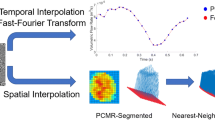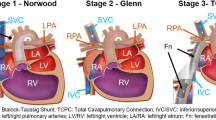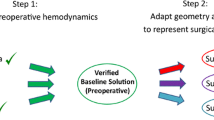Abstract
The Fontan procedure is a common palliative surgery for congenital single ventricle patients. In silico and in vitro patient-specific modeling approaches are widely utilized to investigate potential improvements of Fontan hemodynamics that are related to long-term complications. However, there is a lack of consensus regarding the use of non-Newtonian rheology, warranting a systematic investigation. This study conducted in silico patient-specific modeling for twelve Fontan patients, using a Newtonian and a non-Newtonian model for each patient. Differences were quantified by examining clinically relevant metrics: indexed power loss (iPL), indexed viscous dissipation rate (iVDR), hepatic flow distribution (HFD), and regions of low wall shear stress (AWSS). Four sets of “non-Newtonian importance factors” were calculated to explore their effectiveness in identifying the non-Newtonian effect. No statistical differences were observed in iPL, iVDR, and HFD between the two models at the population-level, but large inter-patient variations exist. Significant differences were detected regarding AWSS, and its correlations with non-Newtonian importance factors were discussed. Additionally, simulations using the non-Newtonian model were computationally faster than those using the Newtonian model. These findings distinguish good importance factors for identifying non-Newtonian rheology and encourage the use of a non-Newtonian model to assess Fontan hemodynamics.







Similar content being viewed by others
References
Anand, M., J. Kwack, and A. Masud. A new generalized Oldroyd-B model for blood flow in complex geometries. Int. J. Eng. Sci. 72:78–88, 2013.
Arzani, A. Accounting for residence-time in blood rheology models: do we really need non-Newtonian blood flow modelling in large arteries? J. R. Soc. Interface 15:20180486, 2018.
Avitabile, C. M., D. J. Goldberg, M. B. Leonard, Z. A. Wei, E. Tang, S. M. Paridon, A. P. Yoganathan, M. A. Fogel, and K. K. Whitehead. Leg lean mass correlates with exercise systemic output in young Fontan patients. Heart 104:680–684, 2018.
Aycock, K. I., R. L. Campbell, F. C. Lynch, K. B. Manning, and B. A. Craven. The importance of hemorheology and patient anatomy on the hemodynamics in the inferior vena cava. Ann. Biomed. Eng. 44:3568–3582, 2016.
Ballyk, P. D., D. A. Steinman, and C. R. Ethier. Simulation of non-Newtonian blood flow in an end-to-side anastomosis. Biorheology 31:565–586, 1994.
Bernabeu, M. O., R. W. Nash, D. Groen, H. B. Carver, J. Hetherington, T. Kruger, and P. V. Coveney. Impact of blood rheology on wall shear stress in a model of the middle cerebral artery. Interface Focus 3:20120094, 2013.
Bossers, S. S. M., M. Cibis, F. J. Gijsen, M. Schokking, J. L. M. Strengers, R. F. Verhaart, A. Moelker, J. J. Wentzel, and W. A. Helbing. Computational fluid dynamics in Fontan patients to evaluate power loss during simulated exercise. Heart 100:696–701, 2014.
Caballero, A. D., and S. Lain. Numerical simulation of non-Newtonian blood flow dynamics in human thoracic aorta. Comput. Methods Biomech. Biomed. Eng. 18:1200–1216, 2015.
Castro, M. A., M. C. Ahumada Olivares, C. M. Putman, and J. R. Cebral. Unsteady wall shear stress analysis from image-based computational fluid dynamic aneurysm models under Newtonian and Casson rheological models. Med. Biol. Eng. Comput. 52:827–839, 2014.
Cheng, A. L., N. M. Pahlevan, D. G. Rinderknecht, J. C. Wood, and M. Gharib. Experimental investigation of the effect of non-Newtonian behavior of blood flow in the Fontan circulation. Eur. J. Mech. B 68:184–192, 2018.
Cheng, A. L., C. M. Takao, R. B. Wenby, H. J. Meiselman, J. C. Wood, and J. A. Detterich. Elevated low-shear blood viscosity is associated with decreased pulmonary blood flow in children with univentricular heart defects. Pediatr. Cardiol. 37:789–801, 2016.
Chitra, K., T. Sundararajan, S. Vengadesan, and P. Nithiarasu. Non-Newtonian blood flow study in a model cavopulmonary vascular system. Int. J. Numer. Meth. Fluids 66:269–283, 2011.
Cibis, M., K. Jarvis, M. Markl, M. Rose, C. Rigsby, A. J. Barker, and J. J. Wentzel. The effect of resolution on viscous dissipation measured with 4D flow MRI in patients with Fontan circulation: Evaluation using computational fluid dynamics. J. Biomech. 48:2984–2989, 2015.
Corsini, C., C. Baker, A. Baretta, G. Biglino, A. M. Hlavacek, T.-Y. Hsia, E. Kung, A. Marsden, F. Migliavacca, I. Vignon-Clementel, and G. Pennati. Integration of clinical data collected at different times for virtual surgery in single ventricle patients: a case study. Ann. Biomed. Eng. 43:1310–1320, 2014.
DeGroff, C. G. Modeling the Fontan circulation: where we are and where we need to go. Pediatr. Cardiol. 29:3–12, 2008.
Doost, S. N., L. Zhong, B. Su, and Y. S. Morsi. The numerical analysis of non-Newtonian blood flow in human patient-specific left ventricle. Comput. Methods Prog. Biomed. 127:232–247, 2015.
Ensley, A. E., P. Lynch, G. P. Chatzimavroudis, C. Lucas, S. Sharma, and A. P. Yoganathan. Toward designing the optimal total cavopulmonary connection: an in vitro study. Ann. Thoracic Surg. 68:1384–1390, 1999.
Fedorov, A., R. Beichel, J. Kalpathy-Cramer, J. Finet, J. C. Fillion-Robin, S. Pujol, C. Bauer, D. Jennings, F. Fennessy, M. Sonka, J. Buatti, S. Aylward, J. V. Miller, S. Pieper, and R. Kikinis. 3D Slicer as an image computing platform for the Quantitative Imaging Network. Magn. Reson. Imaging 30:1323–1341, 2012.
Good, B. C., S. Deutsch, and K. B. Manning. Hemodynamics in a pediatric ascending aorta using a viscoelastic pediatric blood model. Ann. Biomed. Eng. 44:1019–1035, 2016.
Heiberg, E., J. Sjögren, M. Ugander, M. Carlsson, H. Engblom, and H. Arheden. Design and validation of segment - freely available software for cardiovascular image analysis. BMC Med Imaging 10:1, 2010.
Johnston, B. M., P. R. Johnston, S. Corney, and D. Kilpatrick. Non-Newtonian blood flow in human right coronary arteries: steady state simulations. J. Biomech. 37:709–720, 2004.
Liu, X., Y. Fan, X. Y. Xu, and X. Deng. Nitric oxide transport in an axisymmetric stenosis. J. R. Soc. Interface 9:2468–2478, 2012.
Long, C. C., M. Hsu, Y. Bazilevs, J. A. Feinstein, and A. L. Marsden. Fluid–structure interaction simulations of the Fontan procedure using variable wall properties. Int. J. Num. Methods in Biomed. Eng. 28:513–527, 2012.
Malek, A. M., S. L. Alper, and S. Izumo. Hemodynamic shear stress and its role in atherosclerosis. JAMA 282:2035–2042, 1999.
Marino, B. S., M. Fogel, L. M.-R. Mercer-Rosa, Z. A. W. Wei, P. M. Trusty, M. Tree, E. Tang, M. Restrepo, K. K. Whitehead, S. M. Paridon, and A. Yoganathan. Poor Fontan geometry, hemodynamics, and computational fluid dynamics are associated with worse quality of life. Circulation 25:A18082–A18082, 2017.
Marrero, V. L., J. A. Tichy, O. Sahni, and K. E. Jansen. Numerical study of purely viscous non-Newtonian flow in an abdominal aortic aneurysm. J. Biomech. Eng. 136:101001, 2014.
Pennati, G., C. Corsini, D. Cosentino, T. Y. Hsia, V. Luisi, G. Dubini, and F. Migliacca. Boundary conditions of patient-specific fluid dynamics modelling of cavopulmonary connections: possible adaptation of pulmonary resistances results in a critical issue for a virtual surgical planning. Interface Focus 1:297–307, 2009.
Pike, N. A., L. A. Vricella, J. A. Feinstein, M. D. Black, and B. A. Reitz. Regression of severe pulmonary arteriovenous malformations after Fontan revision and “hepatic factor” rerouting. Ann. Thorac. Surg. 78:697–699, 2004.
Rijnberg, F. M., M. G. Hazekamp, J. J. Wentzel, P. J. H. de Koning, J. J. M. Westenberg, M. R. M. Jongbloed, N. A. Blom, and A. A. W. Roest. Energetics of blood flow in cardiovascular disease: concept and clinical implications of adverse energetics in patients with a Fontan circulation. Circulation 137:2393–2407, 2018.
Robertson, A. M., A. Sequeira, and R. G. Owens. Rheological models for blood. In: Cardiovascular Mathematics: Modeling and Simulation of the Circulatory System, edited by L. Formaggia, A. Quarteroni, and A. Veneziani. Milano: Springer Milan, 2009, pp. 211–241.
Ryu, K., T. M. Healy, A. E. Ensley, S. Sharma, C. Lucas, and A. P. Yoganathan. Importance of accurate geometry in the study of the total cavopulmonary connection: computational simulations and in vitro experiments. Ann. Biomed. Eng. 29:844–853, 2001.
Tang, T. L. E. Effect of Geometry, Respiration and Vessel Deformability on Fontan Hemodynamics: A Numerical Investigation. Atlanta: Georgia Institute of Technology, 2015.
Tang, E., Z. A. Wei, P. M. Trusty, K. K. Whitehead, L. Mirabella, A. Veneziani, M. A. Fogel, and A. P. Yoganathan. The effect of respiration-driven flow waveforms on hemodynamic metrics used in Fontan surgical planning. J. Biomech. 82:87–95, 2019.
Tang, E., Z. A. Wei, K. K. Whitehead, R. H. Khiabani, M. Restrepo, L. Mirabella, J. Bethel, S. M. Paridon, B. S. Marino, M. A. Fogel, and A. P. Yoganathan. Effect of Fontan geometry on exercise haemodynamics and its potential implications. Heart 103:1806–1812, 2017.
Throckmorton, A. L., S. Lopez-Isaza, and W. Moskowitz. Dual-pump support in the inferior and superior vena cavae of a patient-specific fontan physiology. Artif. Organs 37:513–522, 2013.
Tree, M., Z. A. Wei, P. M. Trusty, V. Raghav, M. Fogel, K. Maher, and A. Yoganathan. Using a novel in vitro Fontan model and condition-specific real-time MRI data to examine hemodynamic effects of respiration and exercise. Ann. Biomed. Eng. 46:135–147, 2018.
Trusty, P. M., T. C. Slesnick, Z. A. Wei, J. Rossignac, K. R. Kanter, M. A. Fogel, and A. P. Yoganathan. Fontan surgical planning: previous accomplishments, current challenges, and future directions. J. Cardiovasc. Transl. Res. 11:133–144, 2018.
Trusty, P. M., Z. Wei, J. Rychik, A. Graham, P. A. Russo, L. F. Surrey, D. J. Goldberg, A. P. Yoganathan, and M. A. Fogel. Cardiac magnetic resonance derived metrics are predictive of liver fibrosis in fontan patients. Ann. Thorac. Surg. 2019. https://doi.org/10.1016/j.athoracsur.2019.09.070.
Trusty, P. M., Z. Wei, J. Rychik, P. A. Russo, L. F. Surrey, D. J. Goldberg, M. A. Fogel, and A. P. Yoganathan. Impact of hemodynamics and fluid energetics on liver fibrosis after Fontan operation. J. Thorac. Cardiovasc. Surg. 156:267–275, 2018.
Trusty, P. M., Z. A. Wei, T. C. Slesnick, K. R. Kanter, T. L. Spray, M. A. Fogel, and A. P. Yoganathan. The first cohort of prospective Fontan surgical planning patients with follow-up data: How accurate is surgical planning? J. Thorac. Cardiovasc. Surg. 157:1146–1155, 2019.
Trusty, P. M., Z. Wei, M. Tree, K. R. Kanter, M. A. Fogel, A. P. Yoganathan, and T. C. Slesnick. Local hemodynamic differences between commercially available Y-grafts and traditional fontan baffles under simulated exercise conditions: implications for exercise tolerance. Cardiovasc. Eng. Technol. 8:390–399, 2017.
Wei, Z. A., C. Huddleston, P. M. Trusty, S. Singh-Gryzbon, M. A. Fogel, A. Veneziani, and A. P. Yoganathan. Analysis of inlet velocity profiles in numerical assessment of Fontan hemodynamics. Ann Biomed Eng 47:2258, 2019.
Wei, Z. A., S. J. Sonntag, M. Toma, S. Singh-Gryzbon, and W. Sun. Computational fluid dynamics assessment associated with transcatheter heart valve prostheses: a position paper of the ISO Working Group. Cardiovasc Eng Technol 9:289–299, 2018.
Wei, Z. A., M. Tree, P. M. Trusty, W. Wu, S. Singh-Gryzbon, and A. Yoganathan. The advantages of viscous dissipation rate over simplified power loss as a Fontan hemodynamic metric. Ann. Biomed. Eng. 46:404–416, 2018.
Wei, Z. A., P. M. Trusty, M. Tree, C. M. Haggerty, E. Tang, M. Fogel, and A. P. Yoganathan. Can time-averaged flow boundary conditions be used to meet the clinical timeline for Fontan surgical planning? J. Biomech. 50:172–179, 2017.
Wei, Z. A., P. M. Trusty, Y. Zhang, E. Tang, K. K. Whitehead, M. A. Fogel, and A. P. Yoganathan. Impact of free-breathing phase-contrast MRI on decision-making in Fontan surgical planning. J. Cardiovasc. Transl. Res. 15:1−8, 2019.
Wei, Z., K. K. Whitehead, R. H. Khiabani, M. Tree, E. Tang, S. M. Paridon, M. A. Fogel, and A. P. Yoganathan. Respiratory effects on Fontan circulation during rest and exercise using real-time cardiac magnetic resonance imaging. Ann. Thorac. Surg. 101:1818–1825, 2016.
Yang, W., F. P. Chan, V. M. Reddy, A. L. Marsden, and J. A. Feinstein. Flow simulations and validation for the first cohort of patients undergoing the Y-graft Fontan procedure. J. Thorac. Cardiovasc. Surg. 149:247–255, 2015.
Yeleswarapu, K. K., M. V. Kameneva, K. R. Rajagopal, and J. F. Antaki. The flow of blood in tubes: theory and experiment. Mech. Res. Commun. 25:257–262, 1998.
Acknowledgments
This study was supported by the National Heart, Lung, and Blood Institute Grants HL67622 and HL098252. The authors acknowledge the use of ANSYS software which was provided through an Academic Partnership between ANSYS, Inc. and the Cardiovascular Fluid Mechanics Lab at the Georgia Institute of Technology.
Author information
Authors and Affiliations
Corresponding author
Additional information
Associate Editor Lakshmi Prasad Dasi oversaw the review of this article.
Publisher's Note
Springer Nature remains neutral with regard to jurisdictional claims in published maps and institutional affiliations.
Shelly Singh-Gryzbon and Connor Huddleston—not the current affiliation of the authors. All their work involved in this manuscript was performed when the authors were employees of the Georgia Institute of Technology.
Rights and permissions
About this article
Cite this article
Wei, Z., Singh-Gryzbon, S., Trusty, P.M. et al. Non-Newtonian Effects on Patient-Specific Modeling of Fontan Hemodynamics. Ann Biomed Eng 48, 2204–2217 (2020). https://doi.org/10.1007/s10439-020-02527-8
Received:
Accepted:
Published:
Issue Date:
DOI: https://doi.org/10.1007/s10439-020-02527-8




